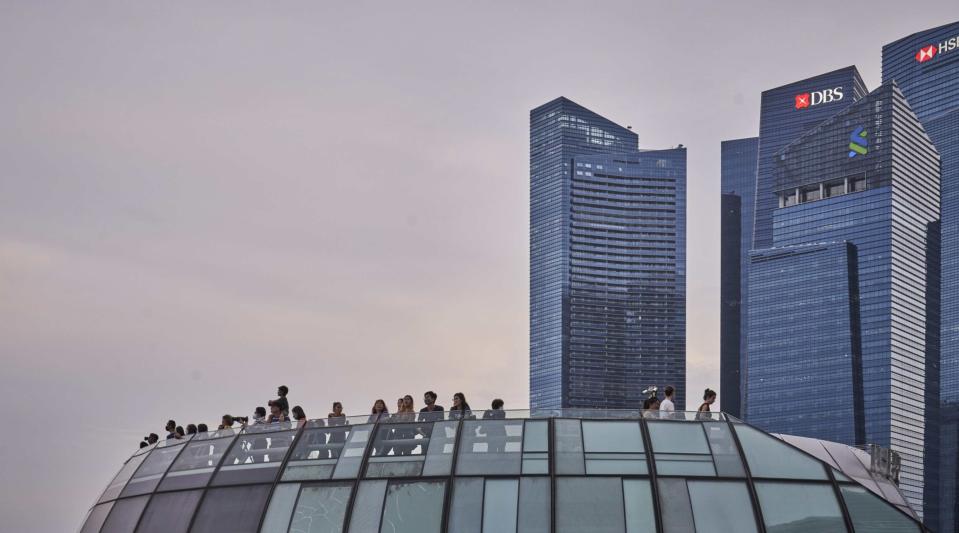RHB keeps 'overweight' rating on Singapore banks; sees overall earnings to improve by 20% y-o-y in FY2023

Among the banks, RHB prefers DBS for its higher NIM sensitivity to interest rate changes, and OCBC, given its cheaper valuation.
The Singapore research team at RHB Group Research is keeping its “overweight” rating on Singapore banks as it sees room for further net interest margin (NIM) expansion in the 1HFY2023.
Noting the “decent start” in the banks’ shares, rising 2% in the first week of 2023, after gaining 7% in 2022, the team notes that tailwinds from net interest margin (NIM) expansion would keep return on equity (ROE) on an upward trajectory, underpinning positive share price re-rating.
Even though the banks’ system current account savings account (CASA) deposits stood 17.4% lower year-to-date (ytd) to November 2022 after rising fixed deposit (FD) rates led to a steep increase of 64% ytd in FDs, the team notes that the banks’ NIM should be lifted further in the FY2023. This is due to the tailwinds from the cumulative 230 basis point (bps) to 240 bps hikes in Singapore’s short term rates in 2HFY2022 and further increases in 1HFY2023 given expectations for another 75bps rise in the Federal Funds Rate (FFR).
For the 9MFY2022, the sector’s NIM expanded by 20 bps on a y-o-y basis, it adds.
“We believe DBS, which had a higher CASA ratio of 60.3% at end-3QFY2022, would be better positioned to deliver NIM improvement,” says the team. “UOB’s CASA ratio stood at 49.8% while Oversea-Chinese Banking Corporation's (OCBC) was 56.1%.”
In the FY2023, the RHB team expects Singapore banks’ earnings to improve by 20% y-o-y on the whole, thanks to further NIM expansion and a moderate rebound in non-interest income. This, says the team, would “comfortably cushion the uptick in credit cost”. This would also lift the sector’s ROE to 13.6% from the 12.0% in the FY2022.
In their report, the team notes that banks are staying prudent for the time being despite their loan portfolios “well-seasoned” after the Covid-19 crisis.
“Sector non-performing loans (NPL) ratio improved to 1.29% in 3QFY2022 from a high of 1.57% in 1QFY2020, and stress tests indicate that asset quality will be resilient, even at interest rates of 6%-7%,” says the team.
“Still, banks are staying prudent, guiding for higher credit cost and preferring not to release management overlays built up to ensure they have strong provision buffers to absorb any potential deterioration in asset quality,” it adds. “As at end-3QFY2022, nonperforming asset coverage stood at a high 120% for DBS, 108% for OCBC and 98% for UOB. We have conservatively pencilled in credit cost of 19 bps for FY2023 – this compared with 14 bps for FY2022.”
Despite the positive outlook, the team notes that loan demand has softened. Based on data by the Monetary Authority of Singapore (MAS), commercial banks have seen a contraction of loans in October 2022 and November 2022.
“We believe businesses are turning cautious while households are tightening their belts due to the rapid rate hikes and uncertain 2023 outlook. This suggests downside risks to our FY2023 loan growth forecast of 5.0% y-o-y [down from the +5.8% in FY2022]. Singapore banks’ loan growth has moderated to 6% (annualised) in 9MFY2022 versus +9.6% in FY2021,” the team notes.
On China’s faster-than-expected pivot on its zero-Covid policy, the RHB team notes that the pivot could create some “near-term risks”, but the move still remains a “long-term positive” for Singapore
In their view, key downside risks to the sector are a sharper-than-expected downturn in global economies, an escalation of the Russia-Ukraine war that would further disrupt commodity exports and intensify inflationary pressures, as well as a significant deterioration in asset quality.
Among the sector, the team prefers DBS for its higher NIM sensitivity to interest rate changes, and OCBC, given its cheaper valuation.
Shares in DBS, OCBC and UOB closed at $35.25, $12.70 and $30.67 respectively on Jan 9.
See Also:
Click here to stay updated with the Latest Business & Investment News in Singapore
Citi keeps 'sell' on SembMarine as it remains cautious on stock’s fundamentals
Maybank Securities downgrade AEM Holdings to 'sell' as margins could be impacted
Get in-depth insights from our expert contributors, and dive into financial and economic trends

 Yahoo Finance
Yahoo Finance 